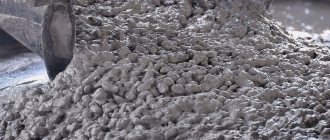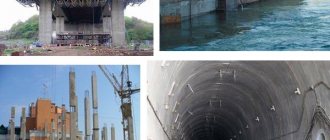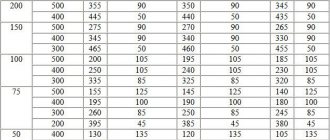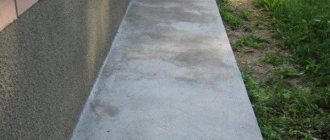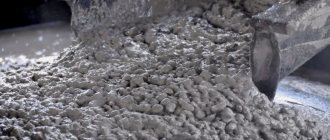Concrete is a clinker-based building material with the addition of water and aggregates. It is used for the construction of foundations, floors and walls, as well as for the production of reinforced concrete products. The quality and properties of the concrete mixture directly depend on the volume and technical characteristics of the cement in its composition:
- The ratio of cement paste to aggregates affects the workability of the material.
- The brand of clinker mixture determines the strength, frost resistance and moisture resistance of the concrete sheet.
- The period of complete mixing of the mortar depends on the class of cement (from 1 to 4 hours).
To prepare concrete of a certain grade and strength, it is necessary to select the correct class of cement and calculate its quantity.
Calculation of the amount of cement per 1m3 of concrete for the foundation
When pouring a monolithic structure, it is necessary to take into account the load on the structure, what kind of solution is needed and the volume of materials. Based on these indicators, it is calculated how much cement is needed per cubic meter of concrete.
If a small barn or bathhouse is being built, the M300 brand is used. To pour the foundation during the construction of a house or cottage, it is necessary to adhere to the cement consumption standards used for the M400 grade.
To prepare a high-quality solution, it is important to maintain the correct ratio of all components - crushed stone, sand, cement, water and additional additives that improve the properties of the finished mixture.
The amount of concrete required for pouring is determined in cubic meters, the material required for mixing is in kilograms, and water is in liters.
Cement is sold in 50 kg bags, sand and crushed stone are delivered to the site in cubic meters, so it is difficult to calculate the required volume of the most expensive component in the mixture.
How to count correctly
Many builders use 10 liter buckets and make calculations based on the ratio: sand - 3, crushed stone or gravel - 5, water - 0.5 and active substance - 1. The bucket includes: sand 18.5-19 kg, crushed stone 15.5 -18 kg, gravel 17 kg and cement 15.6 kg.
Note! These are average indicators that are used in the construction of private houses, bathhouses and outbuildings. With this ratio of components, the foundation is sufficiently strong so as not to collapse during soil movement and settlement of the structure.
Recommended proportions of the mass fraction of cement/sand/crushed stone or gravel:
- M200 – 1/2.8/4.8 (kg);
- M300 – 1/1.9/3.7 (kg);
- M400 – 1/1.2/2.7 (kg).
Depending on the brand, proportions and specific gravity, cement consumption per 1 m3 of concrete averages 330 kg, water 180 liters, crushed stone or gravel 680 kg, sand 400 kg.
Composition of the mixture and its characteristics
The concrete mixture consists of several components. Four of them are mandatory:
- Water.
- Cement.
- Coarse aggregate - crushed stone.
- Fine aggregate - sand.
As necessary, special additives are introduced into concrete - antifreeze, plasticizing, gas-forming, inhibiting, catalyzing, waterproofing, pigment, increasing strength characteristics.
But all of them have limited application and are rarely used in private housing construction.
Binders and fillers
Cement is the most used type of binder in construction. This powder, produced by firing limestone and clay together, binds water to form solid compounds. Cement is not used in its pure form - it cracks when it sets. But in combination with fillers, it shows its qualities.
Cement is characterized by brand and class. The grade is the average tensile strength of a sample from the standard composition of a mixture prepared on the basis of cement, and the class is the guaranteed strength of such a sample.
The grade of concrete that is obtained when using cement depends on the characteristics of both the binder itself and the water-cement ratio, which is the basis for calculating the composition of concrete.
The filler most often is crushed limestone, although in some cases granite is used. Sand serves as a fine aggregate. There are certain requirements for their quality. Thus, they should not contain clay particles, organic contaminants, or chemical impurities. Before mixing, all this must be removed by washing the aggregate.
Parameters of ready-made formulations
The mixing of concrete is calculated in advance, because the characteristics of the finished structure will depend on the proportions of the components. These include the following parameters:
- concrete grade;
- frost resistance;
- water permeability;
- workability;
- hardening time.
The class of the resulting concrete can be assessed later, after 28 days.
But it is possible and even necessary to plan for appropriate strength. If you plan to concrete a structure using a concrete pump, you should consider ensuring that the concrete has a good cone settlement, that is, it is mobile. Otherwise, the pump will either not work or become clogged.
Compliance with technology
When mixing concrete yourself, you should follow the rules for preparing the mixture and laying it. You also need to remember about creating conditions for hardening, especially if this is done in hot, dry or, on the contrary, frosty weather. The sequence of actions during kneading will be as follows:
- Measure out the required amount of ingredients.
- Pour water into the concrete mixer.
- Add all the cement there.
- If it is planned to introduce an additive, then it is added to the water-cement mixture.
- Pour sand and crushed stone into the mixture.
- Mix thoroughly until smooth.
After mixing, the concrete must be checked with a trowel or shovel. It should not delaminate or contain unmixed lumps of sand or cement. It is not advisable to add more water as this will reduce the strength.
The concrete is placed into the formwork immediately. You shouldn’t take long breaks, so it’s better to fill large structures with ready-mixed concrete from a mixer. During installation, the poured mixture must be vibrated. There are special tools for this - vibrators. Small volumes can be compacted with a shovel or knocked on the formwork with a hammer. Failure to comply with this rule will reduce the quality of the concrete - air bubbles will form in it, which will negatively affect the strength and other characteristics of the hardened concrete.
What does consumption depend on?
The amount of cement added per cubic meter. meter of concrete depends on the brand of the required mixture, which is taken into account at the stage of calculating the load on the structure.
To select the proportions of the binder, you need to take into account the mixing conditions, humidity and air temperature when the solution hardens.
When calculating quantities you need to know:
- Quality and moisture content of fine filler. For the solution, clean sand without foreign impurities is used. If the material is dirty with silt and stone inclusions, the binder consumption is increased by 10-15%.
- The grade of powder for preparing concrete must be at least M300. When using a less active dry substance, cement consumption increases by 15-30% per cubic meter. meter.
- Date of manufacture and storage conditions of the dry substance. The shelf life is 6 months, after which the active properties are partially lost and when preparing solutions the rate is increased by 10-20%.
- The required strength, mobility and water resistance of the poured structure. The higher the indicators, the more active substance is needed.
- Size and uniformity of the crushed stone and gravel fraction. High material parameters due to the formation of voids in the solution increase consumption by 10-15%.
- Application of vibration when pouring a structure. If available, it is permissible to mix a heavier solution that requires less dry matter. In the absence of compaction equipment, the solution is made more plastic, increasing the binder consumption by 10%.
Important! It is recommended to use clean and soft water for kneading. The presence of metals and salts in the composition negatively affects the plasticity of the finished mixture.
Do additives affect consumption?
Special plasticizers do not reduce the amount of binder in the solution, but improve the characteristics of the composition. Their use gives concrete properties that are necessary for the object and mixing conditions.
Classification of additives used for concrete:
- plasticizing agents provide the necessary plasticity to the solution;
- accelerators reduce the hardening time of the poured structure;
- retarders increase the hardening time;
- additives to increase strength characteristics;
- water-repellent give the structure additional protection from moisture;
- frost-resistant allow the structure to be poured at sub-zero temperatures;
- expanding make the composition lighter;
- self-compacting ones allow thin-walled structures to be poured without loss of strength.
Special compositions regulate the humidity in the structure being poured and impart special properties that help perform work with materials that do not comply with GOST or under unfavorable weather conditions.
DIY tips and tricks
Many land owners often undertake to produce concrete with their own hands. For small volumes and with non-strict requirements for strength characteristics, such a measure is completely justified.
Tools
To make M300 concrete mix with your own hands, you will need a concrete mixer and hand tools.
Concrete mixer - the type of this mechanism and the volume of its drum depends on the required amount of concrete mixture. To make walkways and fill small areas in the yard, a concrete mixer with a drum volume of 60-80 liters will be sufficient.
When constructing the foundation of a garage, bathhouse, or utility room, the one-time productivity of a concrete mixer should already be 100-120 liters, but in order to prepare the required amount of concrete for the construction of a buried or slab foundation of a residential building, or the foundation for a stone fence, a more solid machine is needed - 150-250 liters.
Hand tools are a shovel for loading bulk ingredients, buckets for pouring water into the mixer, measuring containers for accurately maintaining the proportions of the composition.
Production order
Production should be carried out in the following order.
Pour approximately ¾ of all the water required into the mixer according to calculations. Turn on the rotation of the drum or blades (depending on the type of concrete mixer). Add the required amount of cement to the working volume. As a result of mixing water and cement, laitance will be obtained, which has better adhesive properties. The next addition to the composition is crushed stone, and lastly, sand.
There is no fundamental difference in the order in which ingredients are added, however, the experience of builders shows that it is this order that reduces mixing time and improves the homogeneity of the mixture. Stirring should last at least 5 minutes. The achievement of the required quality and completion of the procedure can be judged by the fact that it is impossible to determine the original color of the crushed stone and sand particles in the mixture - they have all acquired the color of cement mortar.
When using manufactured concrete, it is necessary to remember that from the moment water and cement come into contact, the process of forming solid bonds began, i.e., the mixture began to harden, so it is necessary to work quickly and continuously. The hardening time of concrete decreases with increasing ambient temperature and mixture components.
How much cement is needed depending on the type of concrete
Cement should be purchased with an indicator on the package twice as large as the solution required. If you need a mixture of the M200 brand, then the bag of dry matter should be marked M300-400.
M200
Used for screeding floors, strengthening existing structures and filling garden paths. M200 is not used for foundation construction. The calculation is made using a calculator: the fill height is multiplied by sq. meters of area.
To obtain the solution, you need the M300 grade of cement in an amount of 200 kg.
M300
It is used for pouring foundations during the construction of private sector houses, bathhouses, garages and outbuildings. To prepare the M300 solution, use the M400 brand of binder in an amount of 300 kg per cubic meter.
M400
It is used for the construction of foundations of houses and cottages using a reinforcement frame. This enhances the strength of the structure and allows the construction of multi-story buildings. The brand has good characteristics for performing foundation work during construction.
For 1 cu. a meter of M400 solution will require 300 kg of M400 binder or 350 kg of M300.
Important! When purchasing material, pay attention to the date of manufacture and the flowability of the dry substance in the bag. The period should not exceed 6 months, the packaging must be undamaged and the humidity must be normal, otherwise the consumption of cement to obtain a high-quality mixture will increase by 20%.
The procedure for calculating the ratio of heavy concrete components
The ingredients of concrete are:
- cement, which is marked from M50 to M1000;
- fine aggregate - sand, can be of coarse, medium and fine fractions;
- coarse component – gravel;
- water.
The relative ratio of the components of a concrete mixture can be calculated by knowing the quantity - volume or weight - of concrete and its brand. To convert one unit to another, the specific gravity of the components is used. The density (specific gravity) value can be found in reference books.
The initial data for calculating the proportions of a concrete mixture using an online calculator are:
type of foundation. Copying from the project plan will help calculate the perimeter of the walls or the length of the tape;
brand of concrete. Each brand is characterized by its own ratio of components;
foundation parameters: its height and thickness. This takes into account the fact that the height of the above-ground part of the concrete base should be equal to four times its thickness.
The program calculates the volume of the foundation, i.e. the cubic capacity of the required concrete, by simply multiplying the length of the tape by the thickness and height of the concrete base.
The calculation of components may have a slight difference in composition from the real one, taking into account the specifics of the ingredients used - their humidity, contamination, heterogeneity of aggregate fractions. The proportions are adjusted after the batch is produced for testing.
Does it make sense to use M500 for the foundation?
The brand is used for pouring the foundations of houses with 3 floors and above with embedded metal reinforcement. The cost of M500 cement is significantly higher than its less active analogues, so it is rarely used in low-rise construction.
To obtain concrete M300, prepared from grade M500, take a ratio of 1/2.4/4.3 (kg) - active substance, sand and gravel. Preparation of M400 requires proportions 1/1.6/3.2 (kg). Water is taken at 50% of the amount of cement, but this figure directly depends on the humidity of the fine filler.
If the construction site is located in an area with large temperature differences, high groundwater levels and an aggressive external environment, it is recommended to use the M500 grade with the addition of plasticizing and water-repellent additives to the composition.
Then the structure will be less vulnerable to negative factors and will last longer without damage.
Technical indicators of concrete
The cement mass and water contained in the composition of the prepared solution, when mixed, create a hardening mass that turns into a cement monolith. In this state, this material quickly lends itself to deformation; a huge number of small cracks appear in it, which causes significant shrinkage.
Because of this, strength increases, solution mobility and deformation during shrinkage decrease.
Taking into account the strength value, the concrete composition is divided into classes “B” and grade “M”. The higher the grade number of the concrete composition, the stronger it is. The class indicator of the building material and its brand will determine what type of construction it is used for.
If the construction of an object is carried out according to the design specifications, then the grades of concrete that will be required for pouring the foundation or installing other elements are determined.
Concrete M300: main technical characteristics
- Concrete class M300: B22.5-B25. This characteristic characterizes the compressive strength of hardened concrete and varies from 28 MPa (280 kgf/cm2) to 32 MPa (320 kgf/cm2). The specific strength of concrete depends on the coefficient of variation of a particular mixture, which in turn depends on the homogeneity of the components and the amount of impurities (soil, clay). For example, with a coefficient of variation of 5%, concrete M300 corresponds to class B25, and with a coefficient of variation of 13.5% - class B22.5.
- The specific gravity of 1 m3 of M300 concrete varies from 1,800 to 2,500 kg/m3. This technical characteristic is also called the density of concrete M300, and depends on the type of heavy filler (crushed stone) and the amount of cavities and air bubbles in the thickness of the material. When crushed limestone is used as a heavy filler, concrete has a minimum specific gravity, and when granite crushed stone is used, it has a maximum specific gravity. A decrease in the weight of M300 concrete below 1,800 kg/m3 indicates a violation of the material manufacturing technology.
- Frost resistance: F150-F The numerical value indicates the guaranteed number of freeze-thaw cycles that a structure made of M300 concrete will withstand. The building material, prepared using traditional technology, has a frost resistance of 150 freeze-thaw cycles. To increase frost resistance, special additives are introduced into concrete, vibration is performed, the optimal “Cement-Water” ratio is used, and only granite crushed stone is used as a filler.
- Water permeability W5-W The numerical value indicates the amount of excess water pressure that a 15-centimeter wall made of M300t concrete can withstand - from 5 to 6 kgf/cm2. Increasing water resistance is possible through the use of special additives, the use of hydrophobic cement and increasing the density of concrete by vibration.
- Workability or mobility. Refers to the characteristics of M300 concrete, which depends on the type of equipment used to pour the structure. For example, concrete supplied to the formwork by concrete pumps should have a mobility from P4 to P5. The required amount of mobility is achieved by adding a plasticizer using a certain aodo-cement ratio.
- Price. There are two ways to obtain M300 concrete: buy ready-made material at a concrete plant or mix it yourself. Do-it-yourself production is advisable with a small daily consumption of concrete. In all other cases, it is best to purchase Gostov concrete M300 at a concrete plant. At the time of writing this article, the cost of concrete of this brand ranges from 3,900 to 4,500 rubles per 1 m3 without delivery costs. Delivery is paid separately, depending on the volume of delivery and delivery distance. The price of the material depends on the region, type and brand of filler and the presence of special additives.
Recommendations
Problems often arise when making solutions. Cement of a lower grade is brought to the site than is required for the manufacture of a composition of a certain strength class. To achieve the desired effect, its amount increases by 15%. 10% more fine-grained sand is added and this will not affect the quality.
Most often, cement is offered in 50 kg paper bags. This is a convenient container that allows you to quickly calculate its volume to complete the planned work. To do this, calculate how many bags of cement are contained in 1 cube of concrete. To obtain this volume, M300 will require 329/50 = 6.58 bags or 6 bags and 29 kg. This value is multiplied by the volume of solution that is poured. If you want to make a 40 m³ monolith from M300, then you will need 40·6.58=263.2≈264 bags or 13.2 tons. In this case, the quality of the mixture will fully comply with the declared parameters if the manufacturing technology is followed.
